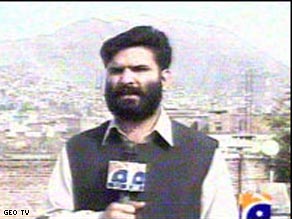By Arfa Khanum Sherwani for TwoCircles.net
The enduring terror trail in Pakistan has not just made a commoner’s life miserable but is constantly posing danger to media fraternity as well. While unrelenting terrorist assaults over the years have built up a certain kind of immunity towards terror and the retort of its citizens towards the menace– uncertainty is the only feature seems certain to them.
This has made an already challenging work of journalists all the more exigent. Instances of missing or kidnapping have become regular impediments to the job. When it comes to the reportage of terrorism incidents is concerned, Pakistan– despite having a bloodied history and being called the ‘most dangerous place’ in the world– does not appear prepared for the challenge. The sudden escalation in terror and unprecedented nature of the recent terror attacks the country is facing makes the journalists look ill-equipped and defenseless to such coercions.

Mosa Khankhel, a journalist with GEO TV was killed in Swat valley in Feb. 2009
According to the Statistical Department of Pakistan, there are 1464 registered newspapers in all languages published in four provinces of Pakistan. The maximum numbers of Urdu newspapers are published in Frontier Province (NWFP) a number as big as 677, influencing policies and people, followed by Baluchistan 363, Punjab only comes next with 268. While Sindh leads in publishing the maximum number of English newspapers (45), followed by Punjab (40), NWFP(25) and Baluchistan the least with 22.
Though free media is still a new phenomenon for Pakistan but there are a number of private players entering the field, most of them are already established businessmen of the country. For advertisers, mostly multi-national companies, Urdu media remains one of the most extensively used vehicle to reach out to their target audiences trying to carve a niche for their brands and attracting new talent for recruitment.
However, low literacy rate – the UNESCO puts the figure at 50%- as well as the high cost of newspapers ( Rs 18) only makes the reading an extravagant affair.
Daily Jung is the largest Urdu Newspaper in Pakistan publishing eight lakh copies a day followed by Daily Nawa-e-waqt and Daily Express competing one another for readers.
Dawn, founded by Muhammad Ali Jinnah in 1941 (in India) is the Oldest and most widely-read English newspaper in Pakistan known for its liberal leanings and supporting leftist social agenda is now playing a crucial role in the ‘war on terror’ by publishing pieces critical to government. Then there are also newspapers doubling-up as mouthpieces of religious and political parties like ‘Jasarat’ reflecting the views of Jamat-e-Islami.

Photo by International Media Support
Not even in the developed western world one can guarantee the safety of those who are in the middle of the battleground dogged to unearth the truth and present the true picture to the world. Even the reporters belonging to the organizations with world standing- like the BBC and CNN get killed and many a times forgotten too. But in a country like Pakistan, where the hazards grow manifold in their very own land while trying to complete the pledge of their profession, there is no mechanism in place to take care of the bare minimum protection one can anticipate.
While doing one of the most deadly jobs on the planet, Pakistani journalists have still managed to put up a brave face and seem undeterred by such killings while being resolute to prolong their battle against radicals. But the big question is how long they should continue forgoing their lives in the absence of a robust mechanism? According to the World Association of Newspapers, this year as many as nine journalists have been murdered by Taliban in the tribal regions.
While overlooking the credentials of the license seekers and largely impervious to the quality of the broadcast programs, the government’s sole trepidation appears to be just charging a hefty amount to provide license to desirous parties. So anyone with an interest and ability to pay the stipulated amount can run the ‘news’ channel and advertise his own interest and ideology.
Lack of training of reporting during war times absence of amenities as basic as a security vest, make mockery of a profession called journalism. As a consequence, this non-serious attitude of the government towards it also leads up to compromise with the principles and values of journalism as well as loss of people’s faith in it.
Today this seems to be the real crisis of Pakistan – a war of information v/s misinformation. But in this age of information, where battles are fought not on the grounds but in the cyberspace, it is high time the government and the journalist community wake up to care or soon it may be too late to cure.
—
Delhi based journalist Arfa Khanum recently returned from a trip to Pakistan.

